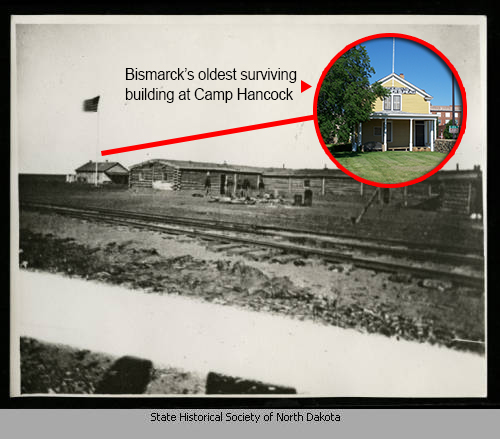You may have learned Bismarck’s precursor as Edwinton, but are you aware of its siblings… Burleighton and Carleton? Or, that the original projected railroad route and correlating town site was to be positioned further south?
Edwinton – the town the evolved into the City of Bismarck – was founded by the Northern Pacific Railway in 1872. It was expected to become a booming railroad hub and major metropolis. Some even hailed it as the “next Chicago.” This perception brought strong interest from early fortune seekers.
Edwinton became Bismarck, officially, on July 17, 1883. The town site was not where Northern Pacific originally intended, however. Some of these early prospectors impeded Northern Pacific’s plans and influenced the city’s destined location.
Squatters Stake Claims
Northern Pacific Railway’s original forecasted route was further south and was anticipated to span the Missouri River at the mouth of the Heart River, across from where Fort McKeen/Fort Abraham Lincoln would be established, at what was referred to as “The Point” or “The Crossing.”
One big problem… squatters seeking to prosper from the principle of adverse possession, colloquially known as “squatter’s rights,” beat them to it. Chief among them was Doctor Walter Burleigh and John Jackman, each of who leveraged their positions to assert land ahead of Northern Pacific’s agents, namely Colonel George W. Sweet.
Colonel Sweet was a lawyer for Puget Sound, Northern Pacific’s auxiliary townsite company. Northern Pacific appointed him to take possession of land for the railroad and town site.
John J. Jackman, a member of Sweet’s own party, resigned upon discovering the point chosen for the Missouri River’s crossing. He organized a five-man party in an effort to preempt land claims ahead of Colonel Sweet. His party arrived only hours before Sweet, occupying roughly two miles along the riverfront.
With the townsite location in dispute, so-called “tent cities” erupted along the original proposed path, namely Carleton and Burleighton (also known as “Burleigh City”). These tent cities thrived in Edwinton’s shadow, swelling to roughly 200 individuals and businesses ranging from saloons to trading posts.
Carleton City, named for Charles Carleton Coffin, sprouted along the riverbank at The Point. To the east, on or near the present-day site of Bismarck Airport, Burleigh City flourished, named for Doctor Burleigh, who held the contract to grade the 50-mile line up to the river.
Another Townsite Foiled
Hindered by squatters, with no legal remedy at his disposal, Sweet retreated to another proposed site. Eager to promptly procure unencumbered land, Sweet hired individuals to take personal possession of land at the new proposed site under the condition that they would sell it to the railroad once proper title could be conveyed.
This plan, too, ultimately failed.
When Jackman learned of Sweet’s latest endeavor, he encouraged others to thwart Sweet’s claims against the land. Governor Jay and others also later laid claim to land in the new townsite. This inevitably lead to a townsite contest that lasted for five years.
Edwinton

Camp Hancock, circa 1872-1875. Bismarck’s oldest surviving building is located here.
Source: State Historical Society of North Dakota (00095-00048-02)
After negations to acquire land claimed by Burleigh and other squatters failed, Sweet proceeded at the embattled town site that would become Bismarck. To the squatters’ dismay, Northern Pacific resolved on the new town site location and adjusted the line accordingly, to its present-day path.
The town was officially christened “Edwinton” on August 17th (some sources say August 24) by order of Northern Pacific, named for Chief Engineer Edwin Johnson. On August 23, Colonel Sculley of Fort Rice and Montgomery Meigs, a Northern Pacific engineer, formally platted and staked out the town.
Impact
The squatters’ actual impact on the line change is debatable.
Another significant cause for the northward shift was to avoid the lowland area’s susceptibility to flooding. Some even alleged that the original route plan itself was a tactical deception from the start, a strategic attempt by Northern Pacific to thwart squatters from inception.
On the other hand, many locals at the time reasonably believed that the change itself was a ruse, disguised to outwit squatters from its actual target. After all, grading work had already been completed along the original path to the river.
In either case, the railroad route as it is ultimately laid was final. The squatters’ stratagem backfired and Edwinton, now Bismarck, is born.
Some log buildings already stood nearby, including those commissioned by Dr. Burleigh – the first of which was used as his home and office. The first framed buildings at the legitimate town site were erected at Camp Greeley/Camp Hancock, shortly after troops first occupied the post on August 8th, one of which remains to this day.


